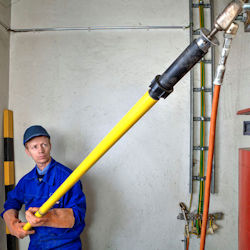Warnings
Warnings can come in the form of visuals, sounds, or even physical sensations. These warnings don't stop someone from being exposed to a hazard, but they do act as a signal to alert people to potential danger. This way, people can take steps to protect themselves or avoid the hazard altogether. OSHA's 1910.145, Specifications for accident prevention signs and tags details the following types of signs:
- Danger Signs - Signs that alert people to specific and immediate dangers (including radiation hazards).
- Warning Signs - Signs that warn people of potential hazards that can lead to death.
- Caution Signs - Signs used to alert people to potential hazards. This class can also be used to caution people against certain unsafe practices. This class is for hazards that can result in minor (non-life threatening) accident or injury.
- Safety Instruction Signs - These signs offer instructions for how someone should act or perform to avoid possible hazards.
Administrative/Work Practice Controls
This is the "next best" strategy, if engineering control methods are insufficient.
Since we can't get rid of the hazard in a JHA step, we'll need to manage exposure to it with safety precautions. Why are administrative controls lower on the hierarchy of controls? To be effective, administrative/work practice controls must rely on appropriate human behavior. According to Arthur Bloch's Murphy's Law - Book Two, "any system relying on human behavior is inherently unreliable." That's the problem. Humans can be rather unpredictable. Methods to eliminate or reduce employee exposure to hazards include:
- revising work schedules to reduce the frequency/duration of exposure
- developing procedures for the use of highly hazardous materials
- using a buddy system
In a best case scenario, you might be able to eliminate the need for administrative/work practice controls if hazards can be eliminated through the use of engineering controls. The more reliable or less likely a hazard control method can be circumvented, the better. Bottom line: If you can get rid of the hazard, you don't have to manage exposure to the hazard!
Knowledge Check Choose the best answer for the question.
4-5. If you can eliminate the _____, you don't have to manage _____.
You forgot to answer the question!

